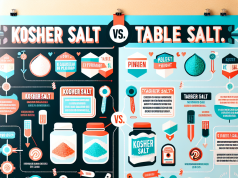Contents
Chef-Approved Tips for Using a Salt Mill in All Your Recipes!
Are you looking for a way to enhance the flavor of your dishes? Look no further than a salt mill. This simple kitchen tool can make a big difference when it comes to seasoning your recipes. But before you start grinding away, here are some tips from professional chefs to help you get the most out of your salt mill:
Choose the Right Type of Salt
Not all salt is created equal. There are many different types to choose from, including sea salt, Himalayan pink salt, kosher salt, and more. Different types of salt have different textures and flavors, so choose the one that best complements your dish. For example, sea salt is great for seafood, while kosher salt is perfect for meat.
Adjust the Grind
Most salt mills have adjustable settings that allow you to control the size of the grind. Different dishes require different grinds, so experiment with different settings to find what works best for you. A finer grind is great for seasoning sauces and soups, while a coarser grind is perfect for seasoning meat.
Don’t Overuse Salt
While salt can enhance the flavor of your dishes, it’s important not to overuse it. Too much salt can overpower the other flavors in your dish and make it taste unpleasant. Always taste your food before adding more salt.
Clean Your Salt Mill Regularly
Over time, salt can build up in your salt mill and affect the flavor of your food. To prevent this, it’s important to clean your salt mill regularly. Simply fill it with uncooked rice and grind it for a few seconds. The rice will absorb any moisture and salt residue.
By following these tips, you can get the most out of your salt mill and take your cooking to the next level.
Chef-Approved Tips for Using a Salt Mill in All Your Recipes
Why You Should Use a Salt Mill
A salt mill is an essential tool for any kitchen, and for any home cook who cares about the quality of their ingredients. By using a salt mill, you can:
- Control the size of your salt crystals
- Get a fresher, more nuanced flavor from your salt
- Elevate the presentation of your food with a finishing touch of freshly ground salt
So, if you haven’t already invested in a salt mill, now is the time.
Choosing the Right Salt Mill
When it comes to choosing a salt mill, there are a few factors to consider:
- Size: Think about how much salt you’ll use, and choose a size that will be easy for you to handle.
- Material: While plastic salt mills are cheaper, they can also be less durable. Consider investing in a mill made of stainless steel, ceramic or glass.
- Grinder mechanism: There are two common types of salt mill grinder mechanisms: a burr grinder and a blade grinder. Burr grinders are more expensive but more durable, while blade grinders are cheaper but not as effective in grinding larger salt crystals.
Using Your Salt Mill
Now that you have your salt mill, it’s time to start using it! Here are Chef-Approved tips for using a salt mill in all your recipes.
- Choose the right salt: Not all salt crystals are created equal. Use a flaky sea salt or Himalayan pink salt for the best results.
- Adjust the grind: Depending on the recipe, you may want finer or coarser salt crystals. Adjust the grind by turning the dial at the bottom of your salt mill, or using the adjustment screw if it has one.
- Grind over finished dishes: Instead of seasoning your food with pre-ground salt, grind fresh salt over the finished dish for a more nuanced and flavorful taste.
- Store your salt mill properly: Keep your salt mill in a dry place, away from any moisture to prevent the salt from clumping or corroding your mill.
Conclusion
A salt mill is a versatile and essential tool in any kitchen, and by using these chef-approved tips, you’ll be able to turn even the most basic dish into a flavorful masterpiece. So, invest in a good-quality salt mill today and start elevating your cooking game.
Reference:
To learn more about salt mills, visit this website: Serious Eats
Chef-Approved Tips for Using a Salt Mill in All Your Recipes
Have questions about using a salt mill in your cooking? Check out these FAQs!
What is a salt mill?
A salt mill, also known as a salt grinder, is a kitchen utensil used to grind coarse salt into smaller, more uniform particles for use in recipes. It typically consists of a mechanism to grind the salt, a container to hold the salt, and a knob or crank to turn the mechanism.
Why use a salt mill instead of pre-ground salt?
Using a salt mill allows you to control the texture and size of the salt particles added to your recipes. Pre-ground salt can often be too fine and can dissolve too quickly, resulting in uneven flavor distribution. Freshly ground salt also tends to have a more intense and complex flavor profile than pre-ground salt.
What type of salt should I use in my salt mill?
The type of salt you use in your salt mill is a matter of personal preference. Some chefs prefer to use sea salt for its mineral content and unique flavor. Others prefer Himalayan pink salt for its distinctive color and texture. Whatever type of salt you choose, be sure that it is coarse enough to be ground by your salt mill.
How do I refill my salt mill?
To refill your salt mill, simply unscrew the top of the mill or remove the bottom cap. Fill the container with your desired salt and replace the top or cap. Be sure to adjust the grind setting on your mill as needed for the type of salt you are using.
How do I clean my salt mill?
To clean your salt mill, wipe it down with a dry cloth or use a soft brush to remove any trapped salt particles. Do not use water or soap to clean your salt mill, as this can cause damage to the grinding mechanism.
The Importance of Choosing the Best Salt Mill
Why a Salt Mill Is a Must-Have Tool for Every Kitchen?
The right amount of salt can take your meal from good to great. While most people use salt shakers, investing in a salt mill can significantly improve your cooking experience. Salt mills provide more control over the amount of salt you use and they can also enhance the flavor of your food by releasing essential oils and aromas trapped inside the salt.
What to Look for When Choosing a Salt Mill?
When choosing the best salt mill for your kitchen, consider the following:
- Material: Salt mills come in different materials such as wood, ceramic, and stainless steel. Consider a material that is durable and easy to clean.
- Mechanism: Salt mills can have different mechanisms for grinding salt. Choose a mechanism that is adjustable and suits your preference.
- Size: Consider the size of the salt mill, if you have a small kitchen, choose a compact size that doesn’t take up too much counter space.
Conclusion
Investing in the best salt mill for your kitchen is a worthy investment that will enhance your cooking experience. Not only does a salt mill provide more control over the amount of salt you use, it also releases essential oils and aromas trapped inside the salt that can elevate the taste of your food.
To learn more about the benefits of using a salt mill in your kitchen, check out the related Wikipedia page here.
Chef-Approved Tips for Using a Salt Mill in All Your Recipes!
1. Choose the Right Salt
- Use sea salt or kosher salt for best results.
- Avoid table salt, which may contain additives.
2. Grind Fresh
- Grind salt fresh for each recipe to maximize flavor.
- Adjust the coarseness of your salt mill to suit the recipe.
3. Be Mindful of Quantity
- Remember that freshly ground salt is more potent than pre-ground salt.
- Start with a small amount and taste as you go to avoid oversalting.
4. Try Different Salts
- Experiment with different types of salt, such as smoked salt or fleur de sel, to add depth to your dishes.
- Use flavored salts, like truffle salt or garlic salt, to elevate simple recipes.
5. Store Your Salt Properly
- Keep your salt mill clean and dry to prevent rust and other damage.
- Airtight containers are best for storing salt to maintain freshness.







































